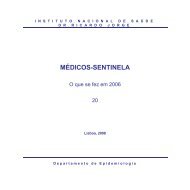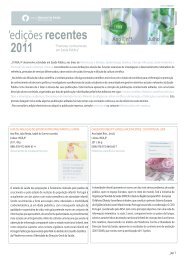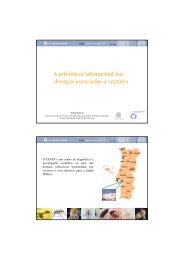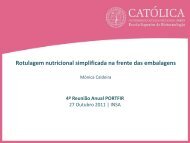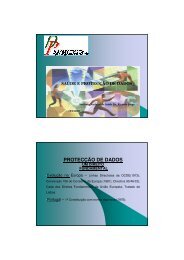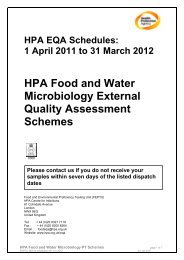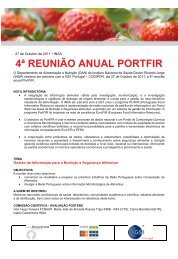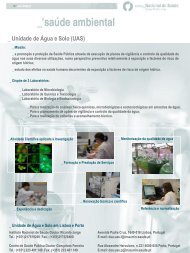European Society of Mycobacteriology - Instituto Nacional de Saúde ...
European Society of Mycobacteriology - Instituto Nacional de Saúde ...
European Society of Mycobacteriology - Instituto Nacional de Saúde ...
Create successful ePaper yourself
Turn your PDF publications into a flip-book with our unique Google optimized e-Paper software.
OP-3<br />
IDENTIFICATION OF THE INSERTION ELEMENT IS6110 IN PHOP<br />
PROMOTER IN A HIGH TRANSMISSION Mycobacterium<br />
tuberculosis STRAIN: A CLUE TO PHENOTYPIC VARIATION<br />
Andrea Sandoval 1,2 , Andrés Cubillos 1,2 , Alejandro Reyes 3 , Nidia Correa 2,4 , Jaime Robledo 2,4 , Maria Merce<strong>de</strong>s Zambrano 1 ,<br />
and Patricia Del Portillo 1,2<br />
1 - Corporación CorpoGen, Bogotá, Colombia.<br />
2 - Centro Colombiano <strong>de</strong> Investigación en Tuberculosis CCITB, Bogotá, Colombia.<br />
3 - Center for Genome Sciences, Washington University School <strong>of</strong> Medicine, St. Louis, Missouri, USA<br />
4 - Corporación para Investigaciones Biológicas CIB, Me<strong>de</strong>llín, Colombia<br />
Aim<br />
The insertion element IS6110 can mediate genetic diversity in Mycobacterium tuberculosis (MTB) strains due to its capacity<br />
to move and cause rearrangements, <strong>de</strong>letions and insertions. Transposition <strong>of</strong> these elements can therefore affect<br />
gene expression and alter the phenotype <strong>of</strong> MTB. In this study we analyzed the insertion sites <strong>of</strong> IS6110 in two clinical<br />
MTB Haarlem genotype strains that present differences in transmissibility as <strong>de</strong>monstrated in a cohort <strong>of</strong> patients and<br />
household contacts from Colombia.<br />
Methods<br />
Restriction Fragment Length Polymorphism (IS6110-RFLP) was performed and revealed genomic differences between<br />
the two strains. DNA was isolated, digested with XmaI and ligated to specific adapters <strong>de</strong>signed for this purpose. Ligation<br />
Mediated PCR (LM-PCR) was carried out to amplify the regions flanking IS6110 insertion sites. A library containing the<br />
amplified products was constructed and sequenced clones were mapped against the annotated sequenced genomes. PCR<br />
was used to confirm the sites <strong>of</strong> insertion.<br />
Results<br />
Twelve different insertions were i<strong>de</strong>ntified; nine were common to both strains (Rv2336, Rv1754c, Rv0963c, Rv0403c,<br />
Rv1358, Rv2813/DR, Rv2254c, Rv0795 and PPE34), two were specific for the high transmission strain (DR region and<br />
transcriptional regulator phoP), and one was found just in the low transmission strain (PPE46).<br />
Conclusions<br />
LM-PCR allowed us to i<strong>de</strong>ntify IS6110 flanking regions and localized the genomic differences between two strains with<br />
contrasting transmission pattern. Most <strong>of</strong> the insertions occur in conserved hypothetical proteins, followed by proteins<br />
involved in cell wall synthesis and cell processes, regulatory proteins and members <strong>of</strong> the PE/PPE family. The DR region,<br />
consi<strong>de</strong>red a hotspot for insertions, had three insertions, two common to both strains and one in the high transmission<br />
strain. Since the phoP gene regulates several functions implicated in virulence, it is possible that the IS6110 insertion in<br />
the phoP promoter could enhance transmission by acting as a portable promoter and inducing gene expression, as has<br />
been reported before in M. bovis.<br />
Acknowledgment<br />
Consorcio Colombiano <strong>de</strong> Investigación en Tuberculosis, CCITB. 4312004<br />
<strong>European</strong> <strong>Society</strong> <strong>of</strong> <strong>Mycobacteriology</strong> | 30 th Annual Congress | July 2009 | Porto - Portugal<br />
45



